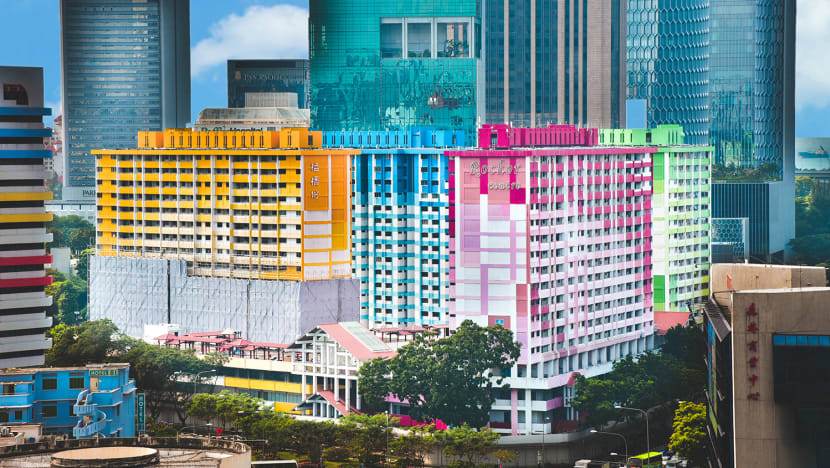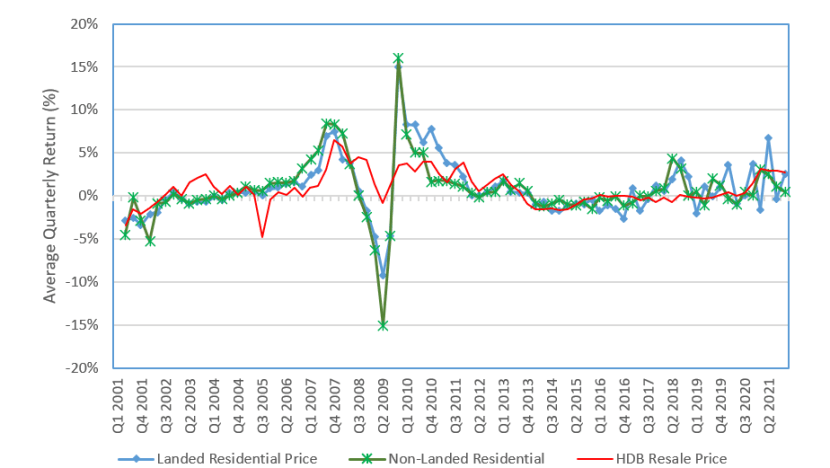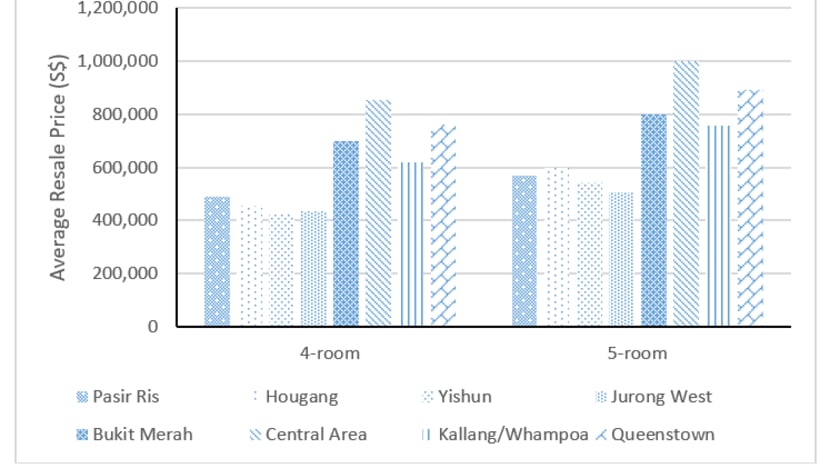Commentary: Are HDB flats still attractive as an investment after new rules for prime locations?
HDB rules have evolved over the decades to help more Singaporeans own their flat while curbing excessive gains. The new PLH model is little different, say NUS’ Sing Tien Foo and Lee Nai Jia.

Hoardings seen on the yellow blocks of Rochor Centre in May 2018. (Photo: Gaya Chandramohan)
SINGAPORE: Singapore might be one of the top countries with the highest proportions of the population owning capital.
For close to 90 per cent of Singaporeans households who own their homes, housing not only provides a roof over people’s heads but also works out to be one of the largest assets families hold over their lifetimes.
Singapore housing has appreciated significantly over the past 20 years, supported by sound macro-economic management and steady job growth over the decades. Resold HDB flats have created significant wealth for households in the last 20 years.
During this period, the resale public housing prices grew at 0.82 per cent per quarter on average, or an accumulated growth of nearly 70 per cent. Private landed, and non-landed residential property price indices have increased by 71.5 per cent and 58.0 per cent, respectively in this same time.

The unique dual features of housing, both as a place to live in and a largely stable and appreciating investment, are mutually reinforcing in a country that continues to grow economically and attract people to come and put roots down.
A Built-to-Order (BTO) home is a benefit reserved for Singaporeans that creates a hefty retirement nest egg.
A 4-room BTO in Fernvale Grove bought in 2004 between S$129,00 and S$162,000 saw an average transacted price of S$469,000 in 2021 – a 222 per cent return.
A resale in the Sengkang vicinity bought at the same time and resold in 2021 fetches about 69 per cent in contrast.
PUBLIC HOUSING AIMS TO PROVIDE AFFORDABLE, INCLUSIVE HOMES
Over the decades, public housing has evolved to meet the higher aspirations of rising upper-middle class Singaporeans who might otherwise be outpriced in the private property market.
Collaboration with private developers to create flats with modern layouts through a Design, Build and Sell Scheme (DBSS) gave birth to 13 such developments after 2006, starting with The Premiere by Sim Lian, before discontinuing in 2012.
Executive condominiums (ECs) - a hybrid housing development with shared facilities like pools, clubhouse, gymnasium room, tennis courts and 24-hours security, which can be privatised after 10 years - also spawned.
More recent iconic projects like those at Dawson - SkyTerrance@Dawson, SkyVille@Dawson, Pinnacle@Duxton - designed by private architects, look like, if not better, than private condominiums.
The latest evolution in housing, the prime location public housing (PLH) model unveiled by Minister for National Development Desmond Lee in October, was designed to give Singaporean families of all income groups a chance to live in the city centre, the Greater Sothern Waterfront, and other central areas.
A 6 per cent subsidy clawback mitigates the risk of excessive windfalls from a resale, along with brakes in the form of 10-year minimum occupation periods (MOP). Homeowners cannot rent out their entire homes at any point and can only sell to a strict pool of eligible buyers.
With all these rules, do people still want to buy these HDB flats? The answer is pretty resounding. The first batch of BTO homes in Rochor has seen healthy demand, at 10.3 times over-subscription.
The PLH follows the spirit of HDB in keeping housing affordable and inclusive. Given the high land costs there, many Singapore families would not otherwise have a chance to live in those places if the building of HDB flats were left solely to the free market.
Land in the city centre would have been outbidded by private developers catering to large enterprises, restaurants, shops, and residents who can afford downtown living.
More ordinary Singaporeans would also miss the chance of long-term economic gains of a home with an attractive location.
More centrally located neighbourhoods in the Central Area, Queenstown, Whampoa, and Bukit Merah have seen no more than 16 per cent of new HDB flats added from 2008 to 2019 despite the number of resident households growing by almost 26 per cent over this period according to SingStat.
Homes there have appreciated faster in prices than farther-flung neighbourhoods like Jurong, Pasir Ris, Yishun, or Hougang.

Analysing resales of Pinnacle@Duxton homes, the only batch of BTO flats built in the Central Area since 2004, buyers who bought from HDB in 2004 (at S$392,100 and S$451,500 for 4- and 5-rooms) and resold in 2021 (at the average resale transacted prices of S$851,868 and $1,001,289) saw their asset appreciate at 7.03 per cent each year over the 17 years – a pace that outstripped the STI Index’s 2.4 per cent for the same period.
NEW RULES FOR PLH TAKE DRESSING FROM PAST CURBS ON EXCESSIVE GAINS IN PUBLIC HOUSING
The PLH’s approach to giving people a stake in the country by helping them own their homes and sell off this asset for a tidy retirement sum while curbing the rent-seeking behaviours of those who aim to flip public housing for monetary gain is not new.
Many past rules have aimed to create barriers between public and private housing for this reason.
MOP rules today restrict EC owners from selling their apartments only to Singaporean citizens and permanent residents after five years, with rules relaxed after 10 years so they can sell to foreigners and corporate entities. Most EC owners make bigger gains after.
Still, these stipulations have curbed the prices of ECs by about 8 per cent relative to other private condos after the 10th year, a study by the NUS Institute of Real Estate and Urban Studies shows.
Our colleagues, professors Kwan Ok Lee and Joseph Ooi, also found a price gap of up to 18 per cent between ECs and private condominiums before the sale restrictions on ECs are lifted before the 10th year.
Similar brakes have been applied to the public housing market, including the extension of the MOP from three to five years after 2010 and rules forbidding private homeowners from buying resale HDB flats for investment purposes.
Still, in the spirit of not hindering HDB owners from investing in other assets, existing HDB homeowners can keep and concurrently invest in private apartments after the MOP of five years.
There have also been measures to tighten the circle of beneficiaries of HDB policies.
Rules after 2013 restrict concurrent ownership of resale HDB flats and private condominiums by Singapore permanent residents – which may explain the higher demand in the private residential market after and the need for cooling measures subsequently.
A WEALTH PRESERVATION CHANNEL
It’s clear that the PLH model is aligned with the Singapore Government’s aim to create advantages for HDB homeowners to keep their homes for a long time. The gains they enjoy as the country prospers will hopefully develop a sense of rootedness and belonging.
Looking ahead, the economic growth that has created a vibrant housing market cannot be taken for granted. In cities that failed to transform their economies, attract investments, and create good jobs, the flight of people led to the depreciation of housing values.
Worryingly, the overall Singapore population shrank its largest decline of 4.1 per cent since last year.
Fortunately, the opening of more Vaccinated travel Lanes may be breathing new life into the property market, where monthly rents for condos and HDB flats have ticked upwards in October, even as the effects of Omicron bears watching.
Listen to Sing Tien Foo discuss developments in the property market since COVID-19 hit on the Heart of the Matter podcast:
The attraction of Singapore homeownership will continue to require healthy prevailing market forces and the astute management of the economy.
The Government knows that it must watch the residential property market carefully. “Beyond being homes, HDB flats are also valuable assets that can be monetised to supplement their owners’ income during their retirement years,” Senior Minister for State for National Development Sim Ann said in Parliament on Nov 2.
Public housing is an important asset, and HDB flat owners, who expect their house value to appreciate over time, must be given a strong investment motive.
If housing does not preserve its value, households will be better off renting instead of owning their homes.
Professor Sing Tien Foo is the Director at the same institute and Head of the Department of Real Estate at the National University of Singapore. Dr Lee Nai Jia is Deputy Director at the Institute of Real Estate and Urban Studies (IREUS). The views and opinions expressed here are those of the authors and do not represent the views and opinions of the National University of Singapore, its subsidiaries, or affiliates.


























